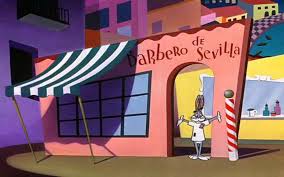Not another Barbiere!

The Rossini Opera Festival has chosen to present “Il Barbiere di Siviglia” in a production by Pier Luigi Pizzi as its third major offering this August.
Considering that this opera has appeared all over the world in the first half of this year (as reported by Rossini150 social media), it may at first seem a strange choice.
Can there be such a thing as too many Barbieres?
Janet Johnson, best known for her reconstruction of Il Viaggio a Reims, contributed an article about Barbiere to the “Cambridge Companion to Rossini” in which she points out that the marvelous scene where Basilio (who is supposedly ill in bed) interrupts Rosina’s lesson was recognized in its own time as one of the funniest ever written. Johnson writes extensively of the cultural background for this opera and we recommend you read her article, particularly if you think you know all there is to know about Barbiere.
Alberto Zedda, who is responsible for the critical edition of Barbiere ( and whose curiousit, stubborness, and love for Rossini ) helped validate the need for critical editions and inspired much of what the Rossini Opera Festival was to become, has also weighed in on Barbiere.
In his recently translated book “A Life with Rossini” (Charles Jernigan, translator) Zedda boldly proclaims that Barbiere is a “Revolutionary Manifesto”. So many of Rossini’s operas can be viewed as “subversive” even today, but sometimes one needs to look under the surface to fully appreciate this. After all this is a fantastically entertaining work which sweeps you away with its energy.
Zedda calls Barbiere “an eloquent manifesto of the revolution brought by Rossini to the lyric theater”
Zedda calls Barbiere “an eloquent manifesto of the revolution brought by Rossini to the lyric theater”.. continuing with the observation that that Rossini chose a subject where the contrast between the declining aristocratic world and the nascent democratic one would be the chief motif of the story. Zedda goes on ” the actors in the story are clearly divided into contrasting groups: one is motivated by a spirit which is decidedly modern; the other is guided by an obtuse conservatism…”
Figaro, who ended up being the most popular character in this opera was not originally intended to be the “star” Rossini had at his disposal the legendary tenor Manuel Garcia; To his talent wrote the final “Cessa pui di resistere”. But things have a way of getting out of the composer’s hands. Figaro, although the most recognizable character (how often has “Largo al factotum” been used in everything from cartoons to commercials) is actually “one-upped” by his own admission in the enchanting duet with Rosina (dunque io son). He admits it and Rosina gets the better of the situation without losing her purported innocence.
Bartolo is not quite what he seems. Some productions present him as a lecherous old man just trying to get his hands on Rosina. Rossini’s music (nor the libretto) doesn’t imply this, rather, Bartolo clearly would like to get his hands on her dowry. That is why he is so easily bought off when Almaviva doesn’t demand it at the end. Bartolo is the embodiment of respectability and requires recognition of his station in life. Some productions, such as the delightful one by Peter Kazakas in Washington DC picture Bartolo’s study with a huge library (and a wonderful engraving of Pasta in Tancredi) on his wall.
Zedda concludes (as has been stated elsewhere that in Barbiere Rossini employed a mode of storytelling that needs the intelligent involvement of the listener, whose duty it is to reassemble the signals in the imagination. As a result “The outcomes of a message like that which is intentionally open-ended, can change from one hearing to the next.”
Or, to put it another way.
One can never have too many Barbieres!
For an interesting lecture by Philip Gossett, you might enjoy.
There is also a very old film about Rossini where the premiere of Barbiere is featured. It is absolutely delightful if “suspect” historically.
https://www.youtube.com/results?search_query=Rossini%2Cfilm+del+1942+di+Mario+Bonnard
And finally, if you are going to change the lesson scene, you can’t do better than this! Tancredi in Barbiere, indeed!
https://www.facebook.com/850266541677506/posts/1550893468281473/
